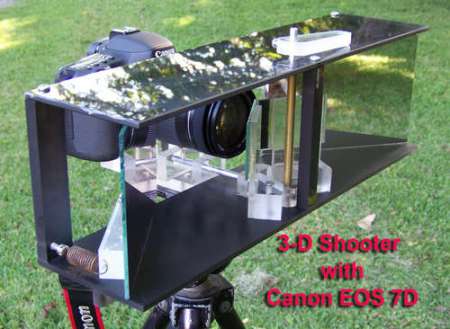
[courtervideo] shares an instructible with us on how to build a mirror rig to take stereoscopic pictures with one camera. We’ve had the thought “couldn’t you just do that with some mirrors?” when looking at a dual camera rig. Well, as we all suspected, you can. There are some advantages here, a single click gives you your 3d image or video without any post processing, and unless you just happen to have an extra camera lying around you can save money there. You do however lose some resolution compared to two separate cameras. This setup could actually add some steps if you were wanting to interlace your images for viewing on a 3d tv.















This is a well known system, there are images of my 4mirror rig on my website and you can find more information at 3dphoto.net forums for stereo photographers.
This system is easier than 2 cameras because you have no sync problems with the video later.
This may have potential for image captures to print with RP gear.
http://www.hizook.com/blog/2009/06/26/computational-cameras-exploiting-megapixels-and-computers-redefine-modern-camera
I forget who/where I saw this link posted. But some fun things cameras can do with just a little bit of computer assistance.
Simple things like this are covered at the start of the video, but the whole thing is well worth the time IMO.
That’s a lot of exposed optics to keep clean. It would be good to put it inside a cheap acrylic case like maybe a reptile tank; then when the acrylic gets scuffed up you can just replace it without having to polish the crap out of your mirrors all day long.
I bought a Loreo (http://www.loreo.com/) a while back for my nikon – not very bright but gives great 3D results and was cheap and easy. I wonder how it compares to this multi-mirror setup.
This is similar to the rig they used on Avatar:
http://tv.gawker.com/5620610/james-cameron-explains-the-3d-camera-rig-created-for-avatar-and-the-future-of-3d-tech
Glad to see they used first surface mirrors. Also, gaad I still hate instructables.
For playing back video captured with this most (if not all) 3D tv’s support side-by-side HDMI input, you just send the video with the 2 separate images down scaled to half their width and combined into a single frame and you can set the TV to interlace them with a press of a button.
If your feeling extra adventurous you can try adding the HDMI 1.4a spec 3D header information to the stream and the TV will interlace it automatically (this may have to be done in hardware, not sure, also the 3DTv will have to support it). HDMI 1.4 defines a bunch of pretty simple standards for 3D (the 3D part of the spec is available for free, after some annoying sign-up stuff from the hdmi website).
Can’t wait to see the headcam version ;)
Good point about no sync issues as with using two cameras, which is especially important when shooting video because even slightly out of sync and things don’t quite seem right, like watching anaglyph or side-by-side version of footage which was shot/created especially for field-sequential viewing as each frame for each eye is offset to each other time wise.
instructables!??!??!!! NOOOOOOOOOOOOOOO!!!!!
if anyone is interested in this, i have a really crazy guy in my flickr contacts.
http://www.flickr.com/photos/fotoopa_hs/
also check his hack to photograph bugs in-flight.
http://www.flickr.com/photos/fotoopa_hs/sets/72157622681513885/
Well, weird thought here, but I wonder if you could make a one-eyed person learn to see in 3d again with something like this. I guess it would have to be a person whose eye only looked straight ahead.
Uh….OK….but….
It’s common knowledge amongst photographers that viewing a single image with just one eye open will also produce the 3-D effect. Works on TV, too.
And the ‘one-eyed person’, although the 3-D effect isn’t normally perceived in the real world, should still be able to perceive the 3-D effect with single photographs and TV, too.
Why? Because viewing ‘flat images’ with just one eye open is much the same as seeing it like a camera lens sees it. The informational cues are there (depth of field, etc.) and the mind
is able to matrix the information and create the optical illusion of depth.
Try watching TV some time with one eye shut. It’s especially effective in close-up scenes with a lot of objects at varying distances and you’ll especially notice it when you see graphics superimposed over a commercial, for instance.
I’m just thinking watching this… This may be a pretty cheep way to record 3d stereoscopic hd videos, since many of these new dslrs have a 1080p recording option.
You could achive a 3d effect by taking the same picture once placing the viewfinder on your right eye and another photo with your left eye.
Gotta love 50 YEAR OLD HACKS! The russians did this back in 1956! http://www.nightphoto.com/zster.html